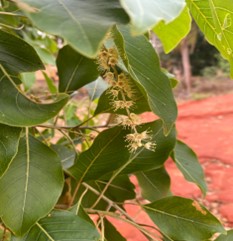Blackberry
Terminalia petiolaris
Nawulu Yawuru
Marool Bardi and Nyul Nyul
Flowering: Laja and Man-gala between October and April
Fruiting: Marul to Laja between April and December
Marool are a large shady and spreading tree that can grow up to 10m, offering a pleasant and cool place to relax when out and about in the Kimberley. They are very hardy, but are semi-decidiuous, and so they drop many leaves at times. In the wet season, the tree can exude an unpleasant pungent odour.
They can be found extensively within Broome town as they are popular for the shade they provide and are planted alongside many local roads. They naturally occur along the Dampier Peninsula coastline and are common in vine thickets, coastal dunes around Roebuck Bay. They are also found in Minyirr Park and up along the coast in places like Quandong.
Marool has strongly scented, cream-white flowers and a small fruit with a large seed. The fruit is edible when the berries turn purplish black. The fruit is often thought to be bitter tasting, although some trees are known to have sweet fruit. The fruit is eaten raw, and the tree also has an edible gum. The gum can be used fresh, or roasted or boiled.
A hybrid between a marool and Gabiny is called Garraliny in Bardi. It is also known as River tree because of its association with watercourses.
For more information: “Broome and Beyond; Plants and people of the Dampier Peninsula, Kimberley, Western Australia” full reference page 89

